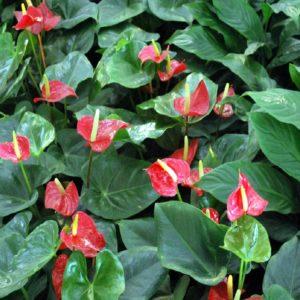anthurium care
Anthurium Care
The Beautiful Anthurium Plant:
A Comprehensive Guide to Planting, Growing, and Caring for Anthuriums.
Welcome to the world of anthuriums! These vibrant and eye-catching plants are a true symbol of elegance and beauty. With their glossy, heart-shaped leaves and stunning flower spathes, Anthurium flowers are perfect for both indoor and outdoor spaces. If you’re looking to add a touch of exotic allure to your home or garden, look no further than the anthurium plant.
In this comprehensive guide, we will delve into all the details you need to know about Anthurium, from planting and growing to caring for these charming plants.
Anthurium Plants:
A Brief Introduction to Anthurium plants, scientifically known as Anthurium andraeanum, belong to the Araceae family. Originating from the tropical regions of Central and South America, these evergreen plants thrive in warm and humid climates. In Hawaii you will see them growing in the wild, Anthurium plants can be found growing on trees or rocks, using their aerial roots to anchor themselves. With their long-lasting blooms and tropical flair, Anthuriums have gained immense popularity in the world of horticulture.
Selecting and Planting Anthuriums: Choosing the Perfect Anthurium Plant: When selecting Anthurium plants, there are a few factors to consider.
Size: Determine whether you prefer a compact or larger-sized anthurium.- Flower Color: Anthuriums come in various shades, including red, pink, white, and even green. Choose one that best complements your aesthetic preferences.- Health and Quality: Ensure that the plant you choose is free from any signs of disease or pests. Healthy leaves, vibrant colors, and smooth stems are indicators of a high-quality plant.
Planting Environment: Anthuriums prefer well-draining soil and indirect sunlight. They can thrive in USDA hardiness zones 1-12 (Indoors) If planting outdoors Zone 9 -12, choose a shaded area protected from harsh winds. If growing indoors, place your Amthurium near a window with filtered light. Keep in mind that temperatures below 60°F (15°C) can adversely affect the growth of anthurium plants.
Soil Requirements: Anthuriums thrive in a mixture of peat moss, perlite, and pine bark. The ideal pH range for these plants is slightly acidic, around 5.5 to 6.5. Ensure proper drainage by adding sand or perlite to the potting mix.
Planting Anthuriums: Here’s a step-by-step guide on how to plant an anthurium: Select a pot with adequate drainage holes. Fill it with the prepared potting mix. Gently remove the anthurium plant from its nursery container, being careful not to damage the roots. Place the plant in the center of the pot, ensuring that the crown (where the stems emerge) is at the soil level. Backfill the pot with additional potting mix, gently firming it around the roots. Water the plant thoroughly, allowing the excess water to drain away.
Growing Anthuriums: Light Requirements: Anthuriums thrive in bright, indirect light. Too much direct sunlight can scorch their leaves, while insufficient light can lead to reduced flowering. Place your anthurium in a location that receives bright, filtered light for optimum growth. Watering: Proper watering is crucial for the health of anthuriums. These plants prefer moist soil but should never be allowed to sit in water. Water your anthurium when the top inch of the soil feels dry. Avoid both overwatering and underwatering, as both can lead to root rot or dehydration.
Fertilizing: Anthuriums benefit from regular fertilization. Use a balanced, water-soluble fertilizer with a ratio of 20-20-20 or 10-10-10. Apply the fertilizer every two to four weeks during the growing season, and reduce or halt fertilization during the winter months.
Pruning and Propagation: To maintain the shape of your anthurium, occasional pruning may be necessary. Remove any yellowing or dead leaves, using clean and sharp pruning shears. Additionally, Anthuriums can be propagated through division or stem plant cuttings, allowing you to expand your tropical collection or share the joy of growing these beautiful plants with others.
Anthurium Care
Humidity: As tropical plants, Anthuriums thrive in high humidity. If the air in your home or garden is dry, consider using a humidifier or placing a tray of water near your anthurium to increase moisture levels.
Pest Control: While Anthuriums are generally resistant to pests, occasional infestations can occur. Keep a close eye on your plant and look out for common pests such as aphids, mealybugs, or spider mites. If an infestation is detected, treat it immediately using organic methods or horticultural insecticides as a last resort.
Temperature and Air Circulation: Maintaining a stable temperature is crucial for Anthuriums. Avoid exposing them to extreme temperature fluctuations, drafts, or cold air. Good air circulation promotes healthy growth and helps prevent the development of fungal diseases.
Wintertime Care: During the winter months, Anthurium plants may enter a period of dormancy or reduced growth. Reduce watering and allow the top layer of soil to dry between waterings. Additionally, ensure that your anthurium is protected from cold drafts and lower temperatures during this time.
Congratulations! You now have the knowledge and tools to successfully plant, grow, and care for your tropical plants. These stunning plants will surely bring a touch of elegance and tropical charm to your surroundings. From selecting the perfect plant to providing the ideal growing conditions, your journey with Anthuriums promises to be rewarding. Take the time to nurture these plants, and soon you’ll be rewarded with their long-lasting blooms and lush foliage – a testament to your green thumb and dedication. Happy gardening with Anthuriums!
Showing the single result
